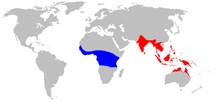Weaver ants
| Weaver ants | ||||||||||
|---|---|---|---|---|---|---|---|---|---|---|

African weaver ant workers ( Oecophylla longinoda ) |
||||||||||
| Systematics | ||||||||||
|
||||||||||
| Scientific name | ||||||||||
| Oecophylla | ||||||||||
| F. Smith , 1860 |
The weaver ants or green ants ( Oecophylla ) are a genus of ants (Formicidae) and belong to the subfamily of the scale ants (Formicinae). Characteristic and eponymous for this genus is the construction of a silk nest, a free nest made of leaves that are " woven " together with silk threads produced by the larvae .
Weaver ants are aphidophilic , i. That is , they often live with myrmecophilic peckers in trophobiosis , who are protected by them and from whom they receive excised nutrients.
Systematics
Two recent species are known: Oecophylla longinoda and Oecophylla smaragdina . Oecophylla longinoda is distributed over the whole of tropical Africa , while the distribution area of Oecophylla smaragdina extends from India to Australia .
Fossils
Many fossil records , mostly preserved in amber , show earlier distribution in Europe.
Extinct species:
- Oecophylla atavina lived in the Oligocene (about 33.9 to about 23.03 million years ago), found on the Isle of Wight
- Oecophylla brischkei lived in the Eocene (about 56 to about 33.9 million years ago), found in Baltic amber
- Oecophylla crassinoda lived in the Eocene, found in Baltic amber
- Oecophylla eckfeldiana lived in Germany in the Eocene about 47 to 43 million years ago and was found fossil in the Messel pit and in the Eckfelder Maar .
- Oecophylla leakeyi lived in East Africa in the Miocene about 30 million years ago, a fossilized nest was found
- Oecophylla megarche lived in the Oligocene, found on the Isle of Wight
confusion
In addition to the genus Oecophylla , ants of the genus Polyrhachis (e.g. Polyrhachis dives ) also use their larvae to spin the nest. From a scientific point of view, however, these ants are not counted among the weaver ants, because unlike Oecophylla they do not build their nests in leaves, but independently look for nesting material and weave it into walls and floors.
media
A documentation from WildCam Australia covers the way of life of the weaver ants , their use for biological pest control and as food. This was edited in German under the title Green ants - Freund oder Feind? Aired on 3sat in 2015 .
Web links
- Antbase images of Oecophylla
- Green ants - friend or foe? , 3sat 2015
Individual evidence
- ↑ a b c d e f g h i j Crozier, Ross H. et al .: A masterpiece of evolution - Oecophylla weaver ants (Hymenoptera: Formicidae). Myrmecological News, Volume 13, 2010, pp. 57-71, PDF.
- ^ Andreas Weißflog: Free nesting of ants (Hymenoptera: Formicidae) in the crown region of humid tropical forests of Southeast Asia . Dissertation at the Department of Biology and Computer Science, JW Goethe University in Frankfurt am Main, 2001 ( PDF; 3.79 MB ).
- ↑ a b c d e f Gennady M. Dlussky, Torsten Wappler, Sonja Wedmann: New middle Eocene formicid species from Germany and the evolution of weaver ants . In: Acta Palaeontologica Polonica Volume 53, No. 4, 2008, pp. 615-626, doi : 10.4202 / app.2008.0406
- ^ Edward O. Wilson, Robert W. Taylor: A fossil ant colony: new evidence of social antiquity. Psyche, Vol. 71, No. 2, 1964, pp. 93-103.
- ↑ Francisco Hita Garcia, Eva Wiesel, Georg Fischer: The ants of Kenya (Hymenoptera: Formicidae) - faunal overview, first species checklist, bibliography, accounts for all genera, and discussion on taxonomy and zoogeography. In: Journal of East African Natural History , Volume 101, No. 2, 2013, pp. 127-222.
- ^ DA, T .: British fossil insects. ( Memento of the original from April 30, 2012 in the Internet Archive ) Info: The archive link was automatically inserted and not yet checked. Please check the original and archive link according to the instructions and then remove this notice. (PDF; 2.5 MB) Proceedings US National Museum, Volume 49, No. 21, 1915, p. 1.
- ↑ Green ants - friend or foe? "First bite then ask" is the survival strategy of the green ant, which despite or perhaps because of its aggressiveness is currently making many new friends not only in Australia. Not only there, but also in Southeast Asia and parts of Africa, it is increasingly being used for ecological pest control. In addition, her larvae provide protein to traditional Thai cuisine, and she herself tastes deliciously like lime. ZDF 3sat, 2015, January 4, 2016, archived from the original on September 23, 2015 ; accessed on January 4, 2016 .


